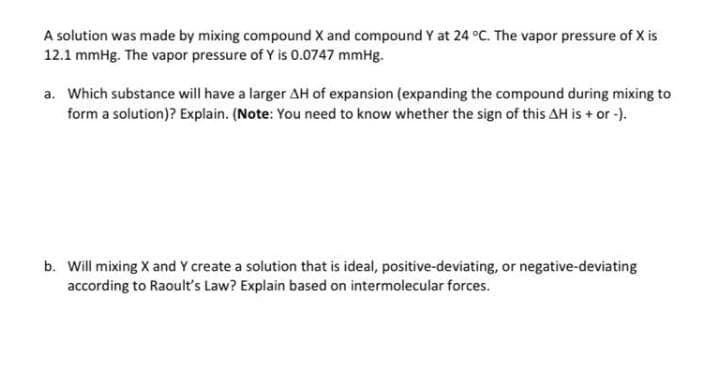A solution was made by mixing compound X and compound Y at 24 °C. The vapor pressure of X is 12.1 mmHg. The vapor pressure of Y is 0.0747 mmHg. a. Which substance will have a larger AH of expansion (expanding the compound during mixing to form a solution)? Explain. (Note: You need to know whether the sign of this AH is + or -). b. Will mixing X and Y create a solution that is ideal, positive-deviating, or negative-deviating according to Raoult's Law? Explain based on intermolecular forces.
A solution was made by mixing compound X and compound Y at 24 °C. The vapor pressure of X is 12.1 mmHg. The vapor pressure of Y is 0.0747 mmHg. a. Which substance will have a larger AH of expansion (expanding the compound during mixing to form a solution)? Explain. (Note: You need to know whether the sign of this AH is + or -). b. Will mixing X and Y create a solution that is ideal, positive-deviating, or negative-deviating according to Raoult's Law? Explain based on intermolecular forces.
Chemistry: An Atoms First Approach
2nd Edition
ISBN:9781305079243
Author:Steven S. Zumdahl, Susan A. Zumdahl
Publisher:Steven S. Zumdahl, Susan A. Zumdahl
Chapter10: Properties Of Solutions
Section: Chapter Questions
Problem 61E: Which of the following will have the lowest total vapor pressure at 25C? a. pure water (vapor...
Related questions
Question
I want clear handwritten solution only....i will up vote

Transcribed Image Text:A solution was made by mixing compound X and compound Y at 24 °C. The vapor pressure of X is
12.1 mmHg. The vapor pressure of Y is 0.0747 mmHg.
a. Which substance will have a larger AH of expansion (expanding the compound during mixing to
form a solution)? Explain. (Note: You need to know whether the sign of this AH is + or -).
b. Will mixing X and Y create a solution that is ideal, positive-deviating, or negative-deviating
according to Raoult's Law? Explain based on intermolecular forces.
Expert Solution
This question has been solved!
Explore an expertly crafted, step-by-step solution for a thorough understanding of key concepts.
Step by step
Solved in 2 steps with 1 images

Knowledge Booster
Learn more about
Need a deep-dive on the concept behind this application? Look no further. Learn more about this topic, chemistry and related others by exploring similar questions and additional content below.Recommended textbooks for you

Chemistry: An Atoms First Approach
Chemistry
ISBN:
9781305079243
Author:
Steven S. Zumdahl, Susan A. Zumdahl
Publisher:
Cengage Learning

Chemistry
Chemistry
ISBN:
9781305957404
Author:
Steven S. Zumdahl, Susan A. Zumdahl, Donald J. DeCoste
Publisher:
Cengage Learning


Chemistry: An Atoms First Approach
Chemistry
ISBN:
9781305079243
Author:
Steven S. Zumdahl, Susan A. Zumdahl
Publisher:
Cengage Learning

Chemistry
Chemistry
ISBN:
9781305957404
Author:
Steven S. Zumdahl, Susan A. Zumdahl, Donald J. DeCoste
Publisher:
Cengage Learning


Chemistry & Chemical Reactivity
Chemistry
ISBN:
9781133949640
Author:
John C. Kotz, Paul M. Treichel, John Townsend, David Treichel
Publisher:
Cengage Learning

Chemistry & Chemical Reactivity
Chemistry
ISBN:
9781337399074
Author:
John C. Kotz, Paul M. Treichel, John Townsend, David Treichel
Publisher:
Cengage Learning

General Chemistry - Standalone book (MindTap Cour…
Chemistry
ISBN:
9781305580343
Author:
Steven D. Gammon, Ebbing, Darrell Ebbing, Steven D., Darrell; Gammon, Darrell Ebbing; Steven D. Gammon, Darrell D.; Gammon, Ebbing; Steven D. Gammon; Darrell
Publisher:
Cengage Learning